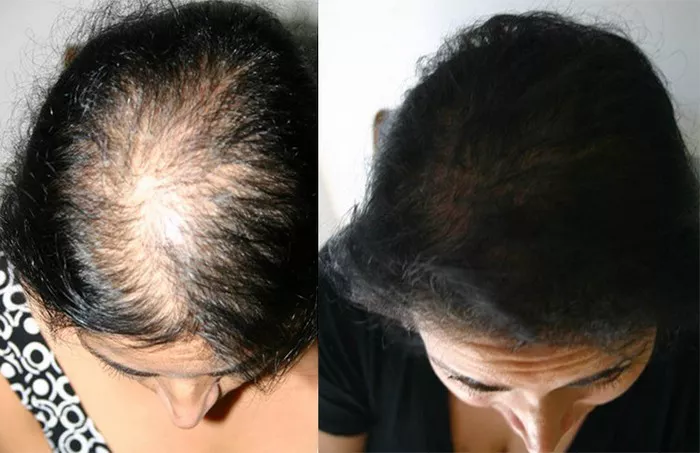Hair is often considered one of the most defining aspects of our appearance, contributing significantly to our sense of identity and self-confidence. However, issues such as hair loss and hair breakage can cause distress and concern for many individuals. While both conditions may seem similar, they are fundamentally different in their causes, mechanisms, and treatments. Understanding these differences is crucial for effectively addressing and managing these common hair-related concerns.
Hair Loss:
Hair loss, also known as alopecia, refers to the gradual or sudden reduction in the density of hair on the scalp or other parts of the body. It can occur due to various factors, including genetics, hormonal changes, medical conditions, medications, and lifestyle choices.
Types of Hair Loss:
1. Androgenetic Alopecia: This is the most common type of hair loss, commonly known as male or female pattern baldness. It is characterized by a progressive thinning of hair, usually starting at the temples or crown in men and the central parting in women.
2. Alopecia Areata: This is an autoimmune condition characterized by sudden, patchy hair loss on the scalp or other parts of the body. It occurs when the body’s immune system mistakenly attacks hair follicles, leading to hair loss.
3. Telogen Effluvium: This type of hair loss occurs when a significant number of hair follicles enter the resting phase (telogen) prematurely due to factors such as stress, illness, childbirth, or certain medications. Hair shedding typically occurs several months after the triggering event.
Hair Breakage:
Hair breakage refers to the physical damage or breakage of the hair shaft, resulting in the formation of split ends, frizz, and overall weakened hair. Unlike hair loss, which involves the loss of hair from the root, hair breakage occurs along the length of the hair shaft.
Causes of Hair Breakage:
1. Excessive Heat Styling: Regular use of heat styling tools such as hairdryers, straighteners, and curling irons can weaken the hair shaft, making it prone to breakage.
2. Chemical Treatments: Harsh chemical treatments like bleaching, perming, and coloring can strip the hair of its natural oils and protein, leading to dryness and breakage.
3. Poor Hair Care Practices: Brushing or combing hair too vigorously, using abrasive hair ties, and sleeping on rough surfaces can cause mechanical damage to the hair, resulting in breakage.
4. Environmental Factors: Exposure to environmental aggressors such as sun, wind, and pollution can damage the hair cuticle, making it more susceptible to breakage.
Distinguishing Between Hair Loss and Hair Breakage:
While both hair loss and hair breakage can result in a reduction in hair density and volume, several key differences help distinguish between the two conditions:
1. Location of Hair Loss: In hair loss, the thinning or loss of hair occurs predominantly at the scalp or other specific areas of the body, whereas hair breakage affects the length of the hair shaft.
2. Presence of Root: Hair loss typically involves the shedding of hair from the root, whereas hair breakage leaves the hair follicle intact, with the broken hair shaft visible along its length.
3. Underlying Causes: Hair loss is often linked to genetic predisposition, hormonal imbalances, medical conditions, or medications, whereas hair breakage is primarily caused by external factors such as heat styling, chemical treatments, and poor hair care practices.
4. Pattern of Hair Loss: Hair loss may exhibit a distinct pattern, such as thinning at the temples or crown in androgenetic alopecia, whereas hair breakage can occur randomly along the length of the hair shaft.
Treatment and Management:
Treatment approaches for hair loss and hair breakage differ based on their underlying causes:
1. Hair Loss Treatment:
- Medications: Topical solutions or oral medications such as minoxidil and finasteride may help promote hair growth and prevent further hair loss in conditions like androgenetic alopecia.
- Platelet-Rich Plasma (PRP) Therapy: This procedure involves injecting concentrated platelets from the patient’s blood into the scalp to stimulate hair growth.
- Hair Transplantation: In cases of advanced hair loss, surgical procedures such as follicular unit transplantation (FUT) or follicular unit extraction (FUE) can restore hair density by transplanting healthy hair follicles from donor areas to balding or thinning areas.
2. Hair Breakage Management:
- Trimming: Regular trims to remove split ends can prevent further breakage and improve the overall health and appearance of the hair.
- Gentle Hair Care: Adopting gentle hair care practices such as using a wide-tooth comb, minimizing heat styling, and avoiding tight hairstyles can help prevent further damage and breakage.
- Moisturizing Treatments: Deep conditioning treatments, hair masks, and leave-in conditioners can help hydrate and strengthen the hair, reducing the risk of breakage.
- Protective Styling: Opting for protective hairstyles such as braids, twists, or buns can minimize exposure to environmental stressors and reduce mechanical damage to the hair.
Conclusion:
Hair loss and hair breakage are common hair-related concerns that can impact individuals of all ages and genders. While they may share some similarities in terms of their effects on hair density and volume, understanding the underlying differences between the two conditions is essential for accurate diagnosis and effective treatment. By addressing the root causes and adopting appropriate management strategies, individuals can take proactive steps towards maintaining healthy, vibrant hair. Consulting with a dermatologist or trichologist can provide personalized guidance and treatment options tailored to individual needs, ensuring optimal outcomes in the management of hair loss and hair breakage.


